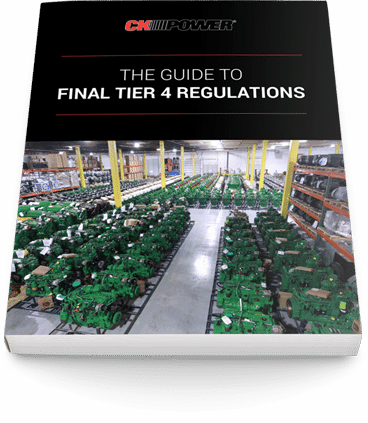It’s crunch time for implementing the emission standards for final Tier 4 engines and Tier 4 generators. Over time, understanding both what these standards are trying to achieve and whether or not they apply to a particular application has become complex. In the interests of making them a little easier to digest, we’ve designed a few visual representations of some of the most important aspects of the new EPA standards, which you can access by scrolling down below.
The graphic provides some background information and illustrates three key concepts that are crucial to understanding the implementation guidelines for Tier 4 engines. You can download a complete catalog of CK Power’s Tier 4 engines here.
For more information on what the EPA’s final Tier 4 standards entail, who they affect and how they’re met, download our complete guide to Tier 4 engines. You can also learn more about how CK Power helps you become tier 4 compliant by watching the video below.
A timeline for Tier 4 engines
The deadline for having Tier 4 engines is contingent upon the engine’s size. Some larger engines have some flex time beyond 2015, before they must comply with the standards for other Tier 4 engines. In this graphic, we display implementation deadlines by the engines horsepower rating to better illustrate which deadlines have passed for Tier 4 engines, and which are still in flex time. Key moments from the EPA’s tiered emission regulations are also listed.
Final Tier 4 engines and emissions restrictions
New Tier 4 engines are expected to reduce two key pollutants: particulate matter (PM) and nitrogen oxides (NOx). NOx are known to contribute to the formation of ground-level ozone, and PM exposure has been shown to have adverse health effects on the respiratory system. As the infographic shows, previous EPA regulations have been an unqualified success in reducing the amount of these two pollutants emitted.
Which applications call for Tier 4 engines?
Beyond engine size, there’s another factor that can cause some confusion when deciding whether a Tier 4 engine is a necessary upgrade: the engine’s application. The EPA’s tiered system applies to non-road applications, with a few exceptions like legacy and standby equipment. The infographic contains a flow chart based on some of the most common questions we typically ask to determine if an application calls for Tier 4 engines. If you still have questions or are ready to start finding solutions, request a Tier 4 consultation.
To examine the graphic more closely, click on the window to expand.
Embed this on your site
Copy the code below and paste it to your site.
Looking for more resources for Tier 4 engines?
Have a specific application problem, such as ordering equipment or base constraints? You might find the answer in a recent blog post we wrote about common tier 4 engine problems, or you can reach out to a specific department of CK Power directly for more information.

